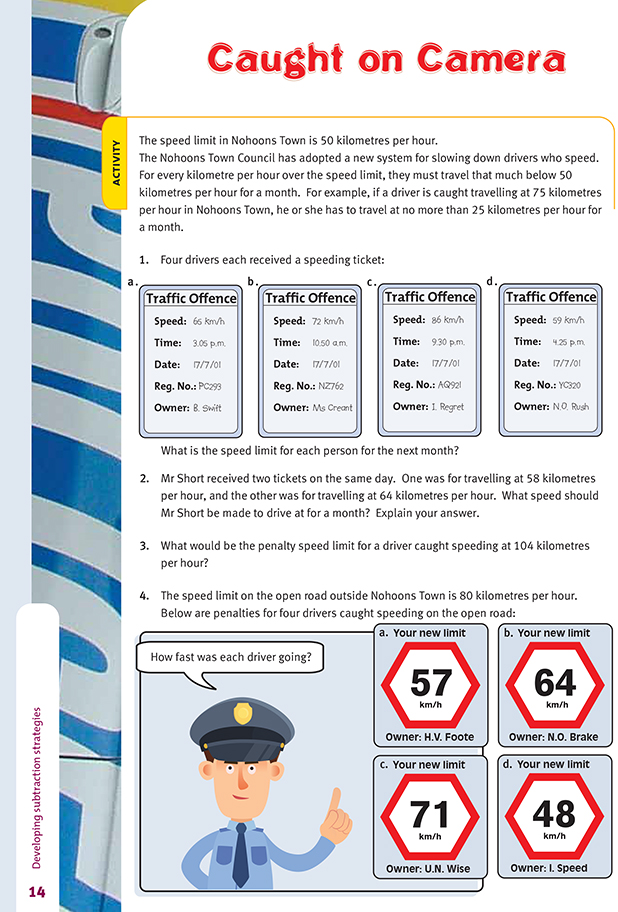This is a level 2 number link activity from the Figure It Out series. It relates to Stage 5 of the Number Framework.
A PDF of the student activity is included.
Click on the image to enlarge it. Click again to close. Download PDF (189 KB)
use mental strategies to solve subtraction problems
FIO, Link, Number, Book One, Caught on Camera, page 14
You can have some fun with this interesting scenario. As a side topic, you might like to discuss ways of ensuring that drivers do keep to their correct speeds. The students may have heard about governors that can be attached to motors to keep them below a certain speed. Possibly the cars could have a large sign displayed that indicates their maximum speed so that other drivers know the speed they should be travelling
at.
After the students have warmed up with question 1, have them work in problem-solving groups of four to find as many possible options for question 2 as they can.
In question 3, the students need to apply some common sense rather than simply calculating and coming up with a negative number that would have the driver moving backwards at 4 km/h. You could use this as an opportunity to discuss negative numbers. The students may not be aware that -4 km/h means moving
backwards.
Question 4 changes the focus of the activity. These are called part-unknown questions because the equations that directly match the question have one part missing, as in 57 + = 80.
Such questions encourage the students to think carefully about what is happening in order to come up with appropriate equations. The students may solve these questions by counting on or adding on. Alternatively, they could reorganise the elements into the common subtraction form of 80 – 57 =.
These questions also have two parts to them. First, the students will find out how much faster than the speed limit the driver was travelling. When they have calculated this, they will use the information to work out the actual speed that the driver was travelling at. For example, for question 4a, it would be 57 + = 80 and
then 80 + 23 =.
An interesting extension would be to have the students add the speed the drivers were doing to their penalty speed and then divide by 2. This will give them the speed limit. If the students wonder why they need to divide by 2, you could work through one example with them:
To get the driver’s speed, note that 80 – 57 = 23, so the driver was going 23 km/h over the speed limit and so was travelling at 80 + 23 = 103 km/h.
(80 – 57) + 80 = 103
So 80 + 80 =103 + 57 (that is, speed limit x 2 = speed + penalty)
So 80 = 1/2 (103 + 57) or (103 + 57) ÷ 2
In each part of question 4, this is:
4a. (103 + 57) ÷ 2 = 80
4b. (96 + 64) ÷ 2 = 80
4c. (89 + 71) ÷ 2 = 80
4d. (112 + 48) ÷ 2 = 80
They could use this method to check their answers.
Answers to Activity
1. a. 35 km/h
b. 28 km/h
c. 14 km/h
d. 41 km/h
2. Answers will vary. For example:
• 36 km/h because that is the fine for the more serious offence
• The average of both tickets (61 km/h), so 39 km/h as a penalty
• 28 km/h because the total speed over 50 km/h was 22 km/h (8 + 14)
• Do the new speed for one ticket for the first month and for the other ticket the next month.
3. The person wouldn’t be able to drive at all. He or she was 54 km/h over the speed limit. 50 – 54 = –4, and it wouldn’t be practical to drive backwards at 4 km/h.
4. a. 103 km/h
b. 96 km/h
c. 89 km/h
d. 112 km/h
